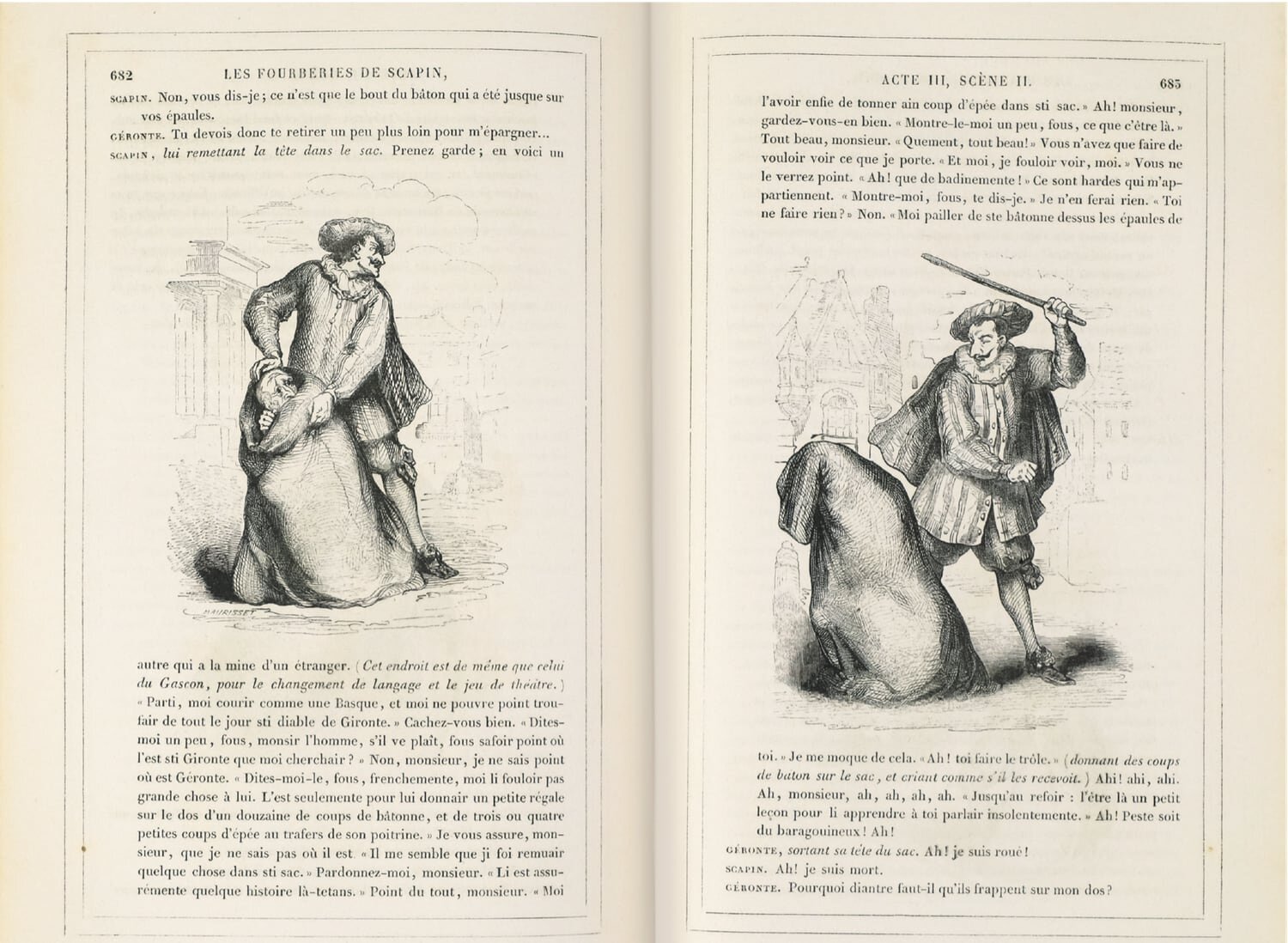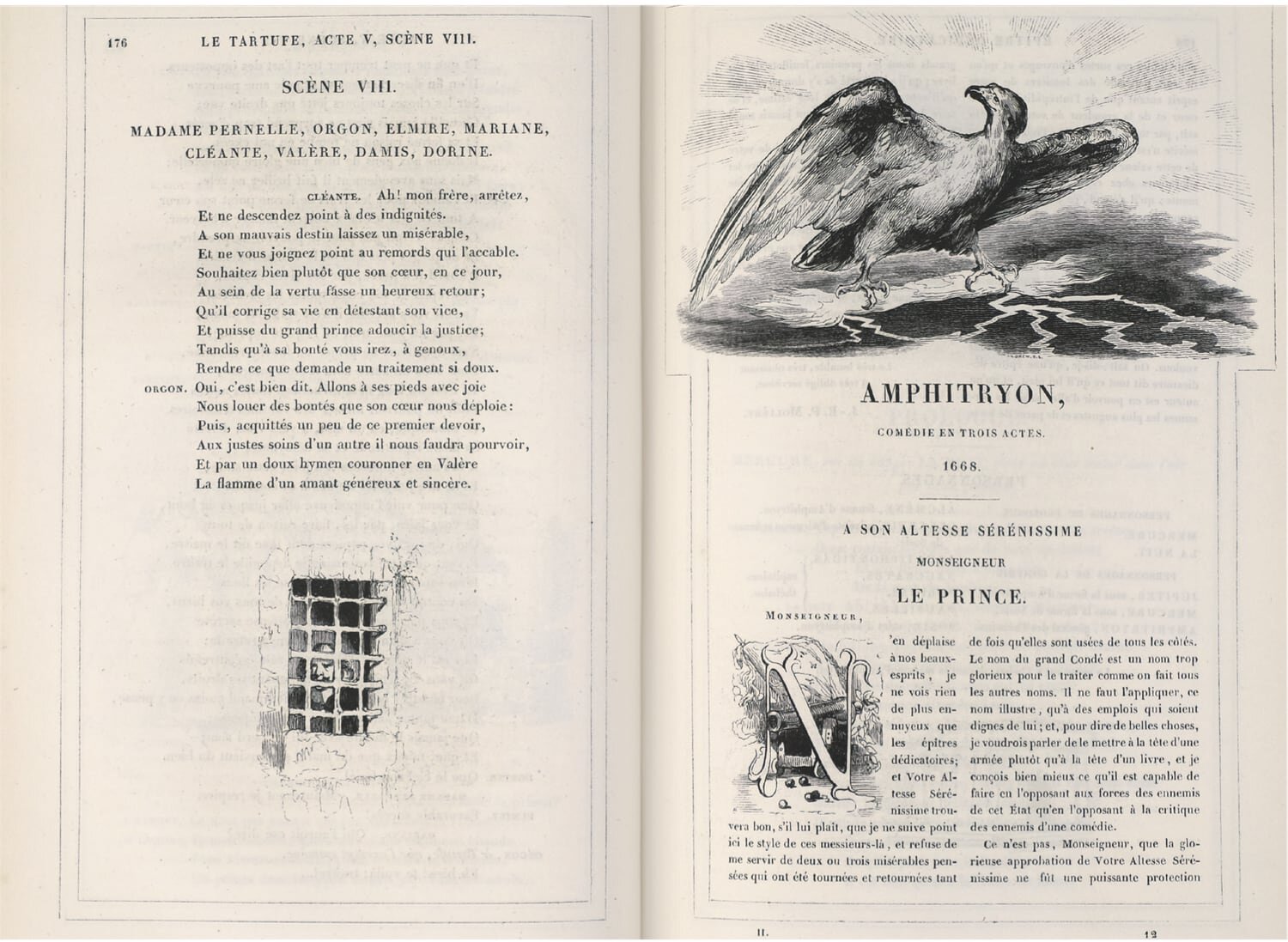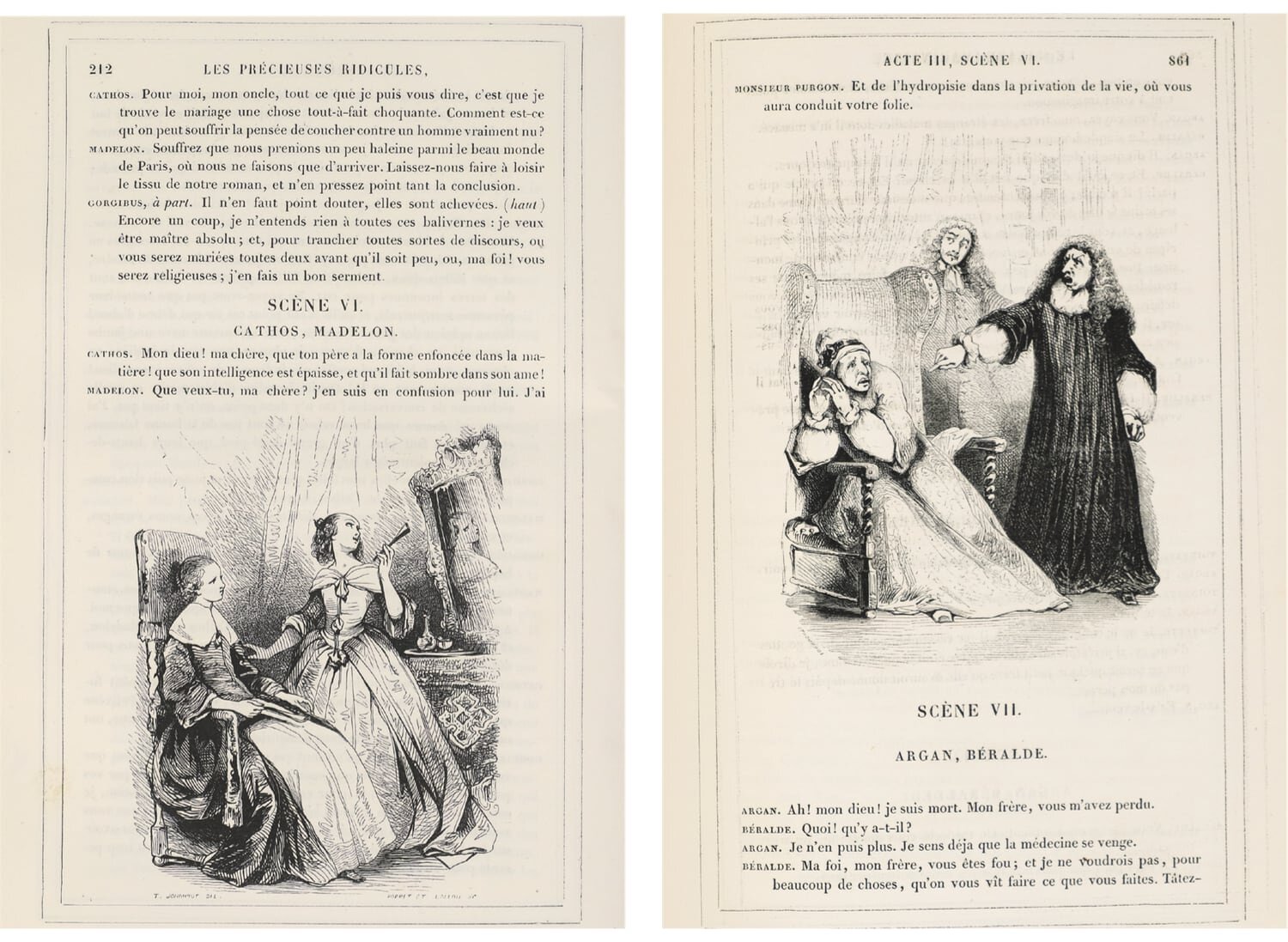VI. Tony Johannot
VI. The most beloved book illustrator of the Romantic period: Tony Johannot illustrates the works of Molière as well as Prévost’s Histoire de Manon Lescot
Tony Johannot was perhaps the most popular book artist of the Romantic period. His illustrations for the editions by works of Molière and Prévost serve as perfect examples for the rich variety of luxury displayed in the finest specimens of the era’s book art.
The edition of Molière’s collected works on display here, which was published almost contemporaneously with Gigoux’s Gil Blas (see case VII elsewhere in our stand), includes around 650 text illustrations by Johannot; undoubtedly the crowning achievement of the woodcut’s revolutionary triumph in Romantic book illustration. Whereas the vignettes at the beginning and end of the individual chapters playfully refer to formal Rococo traditions, the drawings by Johannot accompany the text as “descriptive” commentary: "Never were author and illustrator more entirely in harmony," Gordon N. Ray enthused, while the Johannot connoisseur Aristide Marie praised "an ease, a gaiety, a style of remarkable originality" in the depicted figures and scenes.
The exceedingly beautiful book appears here in a contemporary binding signed by the artist Abich [no. 451]. Its provenance is full of distinguished names: Philippine de Maucler received Molière’s comedies as a present on the occasion of her wedding to Louis Marquis de Vaulchier in 1836; after her death it was acquired by Achille Perreau, whose library was auctioned in 1946; afterwards it was in the possession of Michel Wittock.
Copies on China paper are extremely rare, yet three appear in this collection: one by Lebouf de Montgermont and Antoine Vautier in morocco bindings by Émile Mercier [no. 452], an uncut copy in its original brochures with morocco chemises and cases by Georges Mercier from the collections of Brivois, Roudinesco and Esmerian [no. 453], and finally Henri Beraldi's copy in steel-blue morocco bindings by Bauzonnet [no. 454]: "This is the ideal book," Beraldi himself raved in Estampes et Livres.
Abbé Prévost’s tragic love story about Manon Lescaut, with its mixture of introspection and driving plot, was also a rewarding subject for Johannot’s illustrations. Here the 64 text vignettes are facing 18 full-page illustrations; the Rococo costumes and interiors hark back to the earlier time of the novel’s creation. The publisher’s binding by Boutigny, with portrait medallions of the novel’s protagonists and Rocaille decorations, echoes this stylistic decision: here you can see it in the luxury version bound in red morocco with gold and blind embossing [no. 511], and in the copy bound in green morocco with hand-painted medallions [no. 512].
Only 25 copies of Manon Lescaut were printed on China paper, and even fewer were printed double-sided. Out of those precious few, two are included in our display: we see the copy that belonged to Antoine Vautier and Henri Bonnasse, with its original covers bound into a binding by Émile Mercier [no. 513], as well as the copy of Jules Janin in a contemporary signed morocco binding by Bauzonnet-Trautz [no. 514].
The three copies on China paper with single-sided print also come from important collections: the dark blue Rocaille volume bound by Émile Mercier formerly belonged to Paul Villebœuf and Pierre Duché [no. 516]; an edition bound contemporaneously in red morocco by R. Petit once belonged to Abel Giraudeau, Henri Beraldi, Laurent Meeûs, Georges Lainé, Raphaël Esmerian and Sam Clapp [no. 515]; the third copy, also bound by Petit in a different variation, was once owned by René Descamps-Scrive and André Tissot-Dupont [no. 517, not pictured]. The provenances truly read like a list of the most significant representatives of two centuries of French bibliophilia.




![Molière’s collected works in its contemporary binding, signed by Abich [no. 451]](https://images.squarespace-cdn.com/content/v1/5b02a5098ab7225ab8d3a10c/1591804752212-6NRO3FSBAV4GBXKBQGOL/451.jpg)
![Extremely rare copies of Molière on China paper; in steel-blue morocco bindings by Bauzonnet [no. 454], and another copy in red morocco bindings by Émile Mercier [no. 452]](https://images.squarespace-cdn.com/content/v1/5b02a5098ab7225ab8d3a10c/1591805119840-3CV6NJ8XW2S8VLBFSYII/454.jpg)
![Extremely rare copies of Molière on China paper; in steel-blue morocco bindings by Bauzonnet [no. 454], and another copy in red morocco bindings by Émile Mercier [no. 452]](https://images.squarespace-cdn.com/content/v1/5b02a5098ab7225ab8d3a10c/1591805058399-TQNWTAIKJE16JND3UYN6/452.jpg)
![Manon Lescaut in two examples of its publisher’s binding by Boutigny; in red and green morocco [nos. 511 and 512]](https://images.squarespace-cdn.com/content/v1/5b02a5098ab7225ab8d3a10c/1591805350639-ZMM7OT2VFTR55WPHFOLW/512.jpg)
![Manon Lescaut in two examples of its publisher’s binding by Boutigny; in red and green morocco [nos. 511 and 512]](https://images.squarespace-cdn.com/content/v1/5b02a5098ab7225ab8d3a10c/1591805349225-V1AQI2WUBZRFLEJ7U6FH/511.jpg)
![Two double-sided copies of Manon Lescaut on China paper; one with its original covers bound by Émile Mercier [no. 513], the other in a signed morocco binding by Bauzonnet-Trautz [no. 514]](https://images.squarespace-cdn.com/content/v1/5b02a5098ab7225ab8d3a10c/1591805569751-Z2CHI3VDHOZ39EKKBFE3/513.jpg)
![Two double-sided copies of Manon Lescaut on China paper; one with its original covers bound by Émile Mercier [no. 513], the other in a signed morocco binding by Bauzonnet-Trautz [no. 514]](https://images.squarespace-cdn.com/content/v1/5b02a5098ab7225ab8d3a10c/1591805596471-1UX5QGB2ZT3UN50MHOD1/514.jpg)
![Single sided copies of Manon Lescaut on China paper; one formerly belonging to Paul Villebœuf and Pierre Duché [no. 516], and the other belonging to Henri Beraldi, Laurent Meeûs, and others [no. 515]](https://images.squarespace-cdn.com/content/v1/5b02a5098ab7225ab8d3a10c/1591805887601-0Z6JYN6SRJ61VIV5DEOP/516.jpg)
![Single sided copies of Manon Lescaut on China paper; one formerly belonging to Paul Villebœuf and Pierre Duché [no. 516], and the other belonging to Henri Beraldi, Laurent Meeûs, and others [no. 515]](https://images.squarespace-cdn.com/content/v1/5b02a5098ab7225ab8d3a10c/1591871217947-IJGY3R77K4QG3SP1RMPJ/515.jpg)